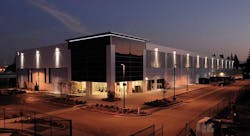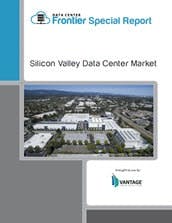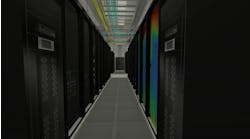Silicon Valley is one of the largest and most important data center markets in the U.S. , and has entered a new phase of acceleration and competition, and is positioned for its strongest growth in years.
Download the 2019 Special Report on the Silicon Valley Data Center Market.
Silicon Valley, which lies south of San Francisco extending roughly from Palo Alto southward to San Jose, includes the Santa Clara Valley, which is known as prime territory for innovation and new tech developments. The dot-com boom helped define a new industry of colocation providers and hosting companies, who began building their own data center facilities around Silicon Valley years ago.
And now, a steady stream of new providers, and a robust cycle of new construction, is continuing to push colocation growth. The cloud computing boom initially played a role in this trend, creating even stronger demand for data centers in past years, and putting more focus on highly connected areas like Silicon Valley.
The region is already home to some of America’s leading tech players, including Apple, Google, Facebook, Intel, Cisco, Oracle and many others.
Interestingly, more data-heavy businesses have looked to Silicon Valley, even as power costs, cost of development sites for Silicon Valley, and land availability in general, puts a damper on data center capacity.
Santa Clara boasts more than 40 data centers located in 18 square miles, rivaling “Data Center Alley” in Northern Virginia as the world’s largest concentration of data centers. The ongoing interest in Silicon Valley is demonstrated in the recent news that data center developer EdgeConneX has bought several properties in Santa Clara for future data center use.
Let’s look at the details. As of 2019, the Silicon Valley Data Center Market was home to 2.9 million square feet (SF) of commissioned data center space, representing 411 megawatts (MW) of commissioned power, according to market research from datacenterHawk. Other recent market size estimates for mid-2021 range from 303 MWs (CBRE) to 508 MWs (JLL).
NTT Global Data Centers Americas opened a new data center in Santa Clara in 2021, while Cologix recently entered the region with the acquisition of the vXchange Santa Clara site. Elsewhere in Santa Clara, Digital Realty has announced a major new project, while Vantage continues to build out its newest campus. In nearby San Jose, STACK Infrastructure and Equinix are expanding their campuses.
Other projects remain in the development pipeline, including projects from new market entrants like CyrusOne and EdgeCore Internet Real Estate.
So why does Silicon Valley remain one of America’s busiest markets for data center space, despite expensive land, comparatively high cost of power and the risk of earthquakes? Proximity to corporations and Internet consumers are major factors.
Santa Clara has become the region’s primary data center hub, due to its lower cost of electric power. Although land is hard to find in the region, developers have found ways around the challenge. Rather than building on open land in other towns, developers have paid more to acquire properties in Santa Clara with existing buildings that must be torn down and redeveloped.
Can Silicon Valley Colo Supply Meet Demand?
Strong activity in both retail colocation and wholesale data center space has spurred the Silicon Valley data center market along. And tenants in the area use this space for a variety of purposes, including corporate IT, research labs and high-performance computing — and cloud deployments.
The Stack Infrastructure campus in San Jose, California; (Source: Stack Infrastructure)
That said, space remains limited, and over the past several years, the limited supply of new wholesale space in Silicon Valley has led to strong leasing and pre-leasing activity, as well as strong pricing.
Will that trend hold true as additional new inventory becomes available from multiple new projects? That depends. But keep in mind; the lead time for procuring a site and building space in Santa Clara is an important factor for cloud players, who seek to deploy capacity in 6 to 9 months in other markets. This reality might just lead to early commitments from customers with short-term requirements.
One thing is for sure, the Silicon Valley remains an important destination for hyperscale cloud providers, as Amazon, Microsoft and Apple, continue leasing wholesale space in Santa Clara, even as they look to expand their facilities into the Pacific Northwest.
But with a vacancy rate of around 4 percent, large footprints are scarcer than ever in Silicon Valley. In fact, the market has absorbed 35 to 40 megawatts of demand annually in recent years.
The newest demand driver in the Silicon Valley region is the growing adoption of artificial intelligence, which is accelerating the need for high-density computing and surrounding services.
Power Pricing & Competitive Factors in the Valley
Power pricing often guides competition in Silicon Valley, where the average power costs range from 9 to 15 cents per kilowatt hour (kWh) — significantly higher than competing data center markets.
Santa Clara is top of mind for most in this market due to lower power pricing costs from the municipal utility, Silicon Valley Power. The utility’s rates average a significant 25 to 40% lower than the cost of power from PG&E in surrounding towns. For the utility’s industrial customers, this equates to a 22-percent drop from the average for PG&E in surrounding towns.
Power is usually a more important cost factor than land in the total cost of building and operating a data center, and Santa Clara will likely remain the nexus of activity in Silicon Valley for years to come.
As far as challenges in the area beyond power cost, think disaster risk. Beyond the California market being a prime earthquake risk, one of the biggest concerns of late are wildfires — a front-of-mind issue after the extensive loss of life and property in recent wildfires. Another challenge for the Northern California data center market is the availability of water, as many facilities need large amounts of water to cool their equipment.
There is currently a limited supply of data center space in Silicon Valley, which has prompted several companies to undertake construction projects to bring additional capacity online. (Photo: Vantage Data Centers)
For connectivity in the area, legacy carriers AT&T, Sprint and Verizon all run long-haul fiber connections on the west side of San Francisco Bay. These fast connections to the Internet backbone work to connect tech businesses from San Francisco in the north to the concentrations of data centers south of the Bay in Santa Clara and San Jose.
Fiber from newer carriers CenturyLink, Cogent, Electric Lightwave, Integra, Level3, M Power, Paxio, Telepacific, XO Communications and Zayo all follow similar paths but also add connections to east Bay Area-suburbs of Berkeley and Oakland in the north, out to the growing eastern suburbs of Dublin, Pleasanton and Livermore, and circle back southwest to link up to San Jose/Santa Clara.
Municipal fiber is available in Palo Alto, Sun Bruno (just south of San Francisco proper) and San Leandro, while Wilcon and Northern California Fiber serve the data center-heavy areas in Santa Clara and San Jose.
The Biggest Colo Players in Northern California
As for the biggest players in the Silicon Valley Data Center Market, here’s a look at the data center providers that operate two or more facilities in the Silicon Valley market, presented alphabetically:
- CoreSite: Located at 55 South Market Street, CoreSite’s SV1 data center is a 15-story carrier hotel building in San Jose and has commissioned multiple data halls inside the over 309,000 SF interior. CoreSite also operates a major multi-tenant campus in Santa Clara, housing its SV2-9.
- Cyxtera: Cyxtera operates six data centers in the Northern California market, and recently leased a 9 megawatt new build in Santa Clara from Prime Data Centers.
- Digital Realty: DLR’s largest concentration of data centers in Northern California is in Santa Clara, where it owns or operates 17 facilities. In February 2021 the company announced plans for more new capacity in Santa Clara.
- Equinix: Equinix operates four data centers in San Jose.
- INAP: INAP operates two Northern California data centers in the Santa Clara cluster to serve Silicon Valley businesses.
- QTS Realty Trust: QTS operates two fully-occupied data centers at 2805 and 2807 Mission College Boulevard in Santa Clara.
- NTT Global Data Centers: In April 2021, NTT Global Data Centers Americas (formerly RagingWire) opened a 16 MW data center in Santa Clara.
- Stack Infrastructure: The company’s San Jose data center is the original “Fortune Data Center” location. The two-story building features 9.3 MW commissioned power and 41,000 SF of data center space. In 2020, STACK pre-leased a 32 MW expansion site on its San Jose campus.
- Vantage Data Centers: Vantage’s flagship Silicon Valley campus in Santa Clara includes six data centers totaling 75 megawatts (MW) of critical IT load. It has now completed two buildings on its new Mathews campus.
Other providers with one facility in the Valley include:
Explore the Silicon Valley Data Center Market further through Data Center Frontier’s special report series and ongoing coverage on one of the largest and most important data center markets in the U.S., which can be found below.









